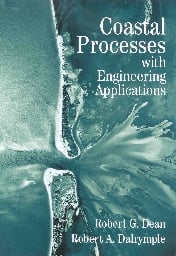| Chapter 1 | |
Chapter 2 | |
| Fig. 2.5: Ordinate is "Grain Size (mm)"
Fig. 2.7: Water temperature curves should be labelled as 0 degrees C for the upper curve increasing by 10 C per curve to 40 degrees C on the bottom.
|
Chapter 3 | |
| P. 44, first footnote: 1987 should be 1988 in reference. |
| p. 66, The reference of Suh and Dalrymple should be replaced by: Suh, K.D., and R.A. Dalrymple, "Expression for Shoreline Advancement of Initially Plane Beach," Waterway, Port, Coastal, and Ocean Eng., Reston, VA: ASCE, 114, 6, 770-777, 1988. |
| Chapter 5 | |
| p. 93, 7th line: 1984 should be 1983. |
| p. 98, Eq. 5.19, h/Hb should be h/hb twice |
| p. 98, Eqs. for α and β :
Hb/Hb should be hb/Hb
| | p. 98, Eq. 5.20. h/Hb should be h/hb
| | p. 102, Eq. 5.32. Hb should be hb
| | p. 103, Eq. 5.33, first term (h+ η) should be (h+overbar(η))
| | Chapter 7 | |
| Example 1: tan (β) should be tan (θ).
|
Chapter 8 | |
| Eq. before 8.57, gs(y) should be qs(y)
; that is, g -> q |
| Chapter 12 | |
| Fig. 12.12; Ordinate is R/Ro. |
|
